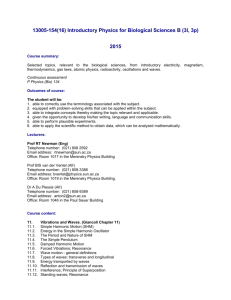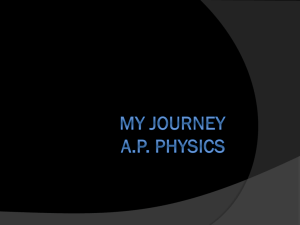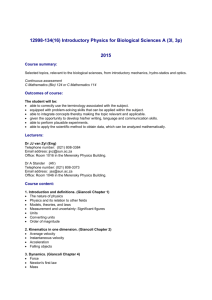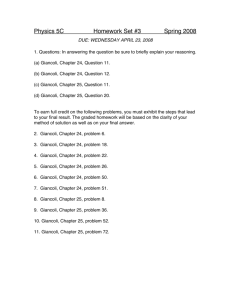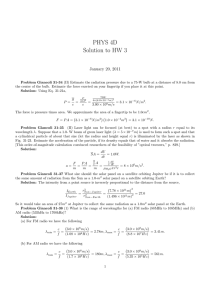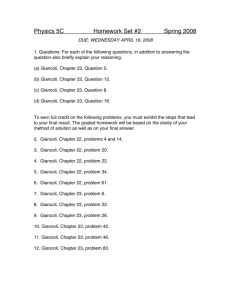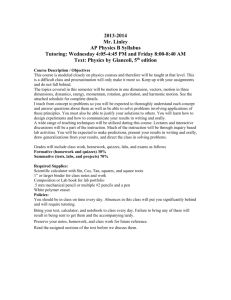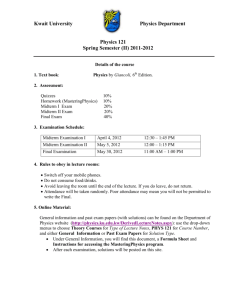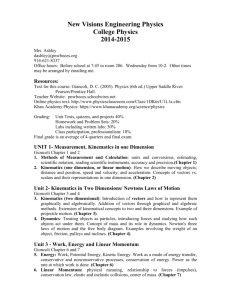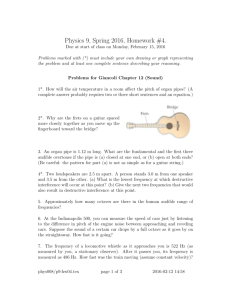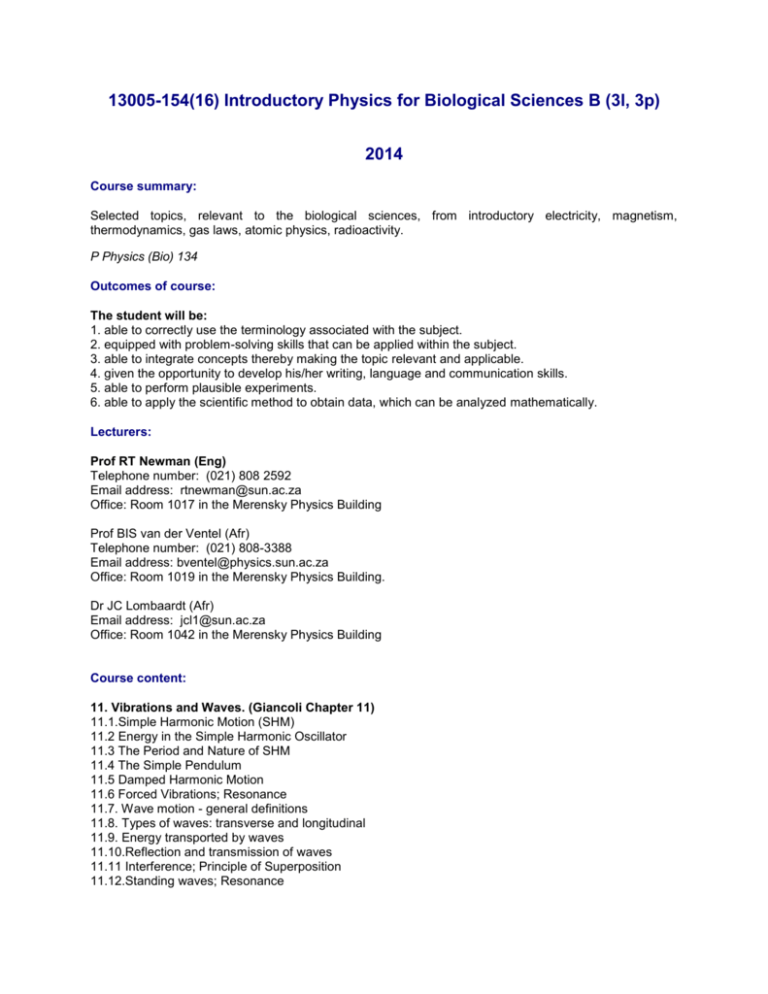
13005-154(16) Introductory Physics for Biological Sciences B (3l, 3p)
2014
Course summary:
Selected topics, relevant to the biological sciences, from introductory electricity, magnetism,
thermodynamics, gas laws, atomic physics, radioactivity.
P Physics (Bio) 134
Outcomes of course:
The student will be:
1. able to correctly use the terminology associated with the subject.
2. equipped with problem-solving skills that can be applied within the subject.
3. able to integrate concepts thereby making the topic relevant and applicable.
4. given the opportunity to develop his/her writing, language and communication skills.
5. able to perform plausible experiments.
6. able to apply the scientific method to obtain data, which can be analyzed mathematically.
Lecturers:
Prof RT Newman (Eng)
Telephone number: (021) 808 2592
Email address: rtnewman@sun.ac.za
Office: Room 1017 in the Merensky Physics Building
Prof BIS van der Ventel (Afr)
Telephone number: (021) 808-3388
Email address: bventel@physics.sun.ac.za
Office: Room 1019 in the Merensky Physics Building.
Dr JC Lombaardt (Afr)
Email address: jcl1@sun.ac.za
Office: Room 1042 in the Merensky Physics Building
Course content:
11. Vibrations and Waves. (Giancoli Chapter 11)
11.1.Simple Harmonic Motion (SHM)
11.2 Energy in the Simple Harmonic Oscillator
11.3 The Period and Nature of SHM
11.4 The Simple Pendulum
11.5 Damped Harmonic Motion
11.6 Forced Vibrations; Resonance
11.7. Wave motion - general definitions
11.8. Types of waves: transverse and longitudinal
11.9. Energy transported by waves
11.10.Reflection and transmission of waves
11.11 Interference; Principle of Superposition
11.12.Standing waves; Resonance
12. Sound. (Giancoli Chapter 12)
12.1. Characteristics of sound
12.2. Intensity of sound: decibels
12.3. Sources of sound: vibrating strings and air columns
12.4. Interference of sound waves; beats
12.5. Doppler effect
12.6. Applications of sound
13. Temperature and kinetic theory. (Giancoli Chapter 13)
13.1. Atomic theory of matter
13.2. Temperature and thermometers
13.3. Thermal expansion
13.4. The gas laws and absolute temperature
13.5. The ideal gas law
13.6. Problem solving with the ideal gas law
13.79. Ideal gas law in terms of molecules: Avogadro's number
13.80. Kinetic theory and the molecular interpretation of temperature
14. Heat. (Giancoli Chapter 14)
14.1. Heat as energy transfer
14.2. Internal energy
14.3. Specific heat
14.4. Calorimetry - solving problems
14.5. Latent heat
14.6. Heat transfer: conduction
14.7. Heat transfer: convection
14.8. Heat transfer: radiation
16. Electric charges and Coulomb's law (Giancoli Chapter 16)
16.1. Electric charge and its conservation, insulators and conductors, induced charge
16.2. Coulomb's law, vectors, examples of calculations
16.3. Electric field, electrostatics, field lines, electric fields and conductors
17. Electric potential, electric energy and capacitance (Giancoli Chapter 17)
17.1. Electric potential, difference, electric potential and field, electron volt, electric potential due to point
charges
17.2. Capacitance, dielectrics, storage of electric energy
18. Electric currents (Giancoli Chapter 18)
18.1. Electric current, Ohm's law, resistivity,
18.2. Electric Power
18.3. Microscopic view of electric current
19. Electric currents (Giancoli Chapter 19)
19.1 EMF and terminal voltage
19.2 Resistors in series and parallel
19.3 Kirchhoff’s rules
19.4 Capacitors in series and parallel
19.5 Resistor and capacitor in series
20. Magnetism and electromagnetic induction (Giancoli Chapters 20 and 21)
20.1. Magnets, magnetic fields, electric currents produce magnetic fields
20.2. Force on an electric current in a magnetic field, between two parallel wires
20.3. Definition of the ampére and the coulomb
20.4. Induced EMF, Faraday's law
20.5. Changing magnetic flux produces an electric field
Practical (Tutorials):
Practical and tutorial schedules will be available on SUNLearn (http://learn.sun.ac.za) at the start of the
semester.
Study material:
Handbook: Physics - Giancoli - 6th edition – Pearson/Prentice Hall
Software that is available via the intranet and on CD.
Learning opportunities:
1. Lectures
2. Tutorials
3. Practicals
All lectures are in the Merensky Building for Physics at the following venues:
Lecture Hall Room number Level
Alpha (English): 0067, Ground floor
Beta (Afrikaans): 3002, 2nd floor
Assessment:
Methods of Assessments
1.
2.
3.
4.
Class test
Tutorial tests
Practical evaluation (short reports, tests and examination)
Examination
Venue and time of assessment opportunities
Available on MyMaties
Calculation of class mark:
Class Mark = 0.5*(Mark for Class test) + 0.1*(Mark for Tutorial tests) + 0.4*(Mark for Practical evaluation)
Calculation of final mark for the module:
Final mark for module = 0.4*(Class mark) + 0.6*(Examination mark)
Admission to examination:
A class mark of at least 40% should be attained in order to qualify for the exam at the end of the year.

